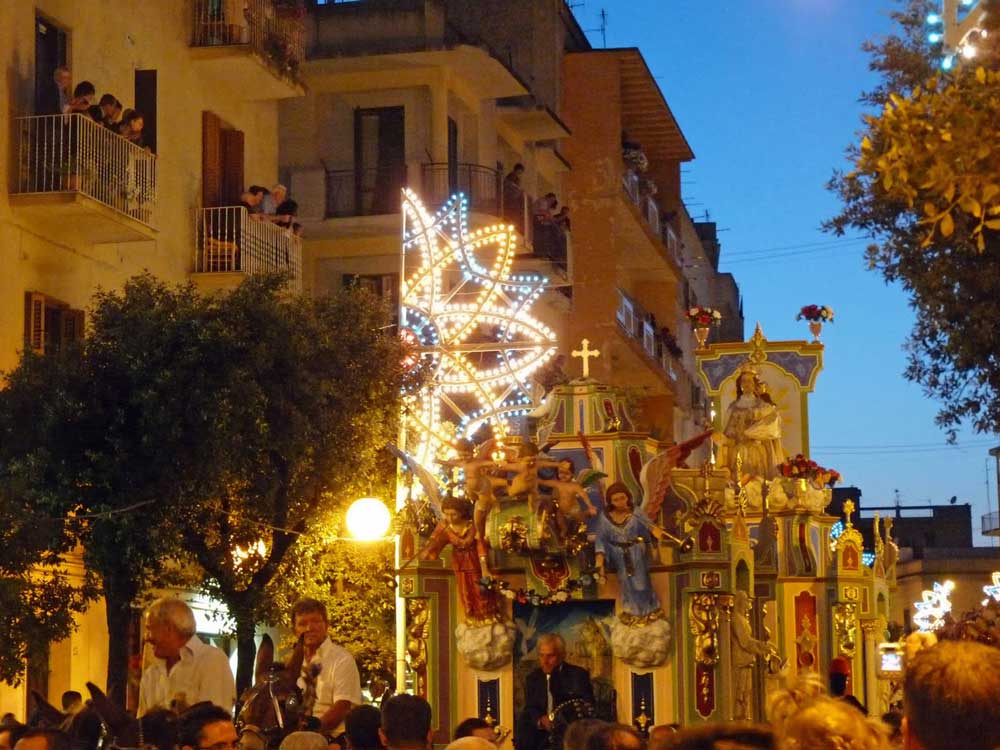The Festa della Bruna (Festa di Maria Santissima della Bruna, Festa della Madonna della Bruna) is the principal festival of the town of Matera, in Italy’s southern Basilicata region. Although the festival is in honour of the town’s sacred protectress, the Madonna della Bruna, it is far from being a purely religious event. Tens of thousands of local people turn out onto the streets for a week of celebrations with coloured lights, market stalls, town bands and grand processions. Events climax with a pagan-style rite of destruction, before a valedictory firework display.
The festival’s main drama takes place on the 2nd July, which is a public holiday in Matera (it is customary in Italy for towns to have their patron saint’s feast day as a bank holiday). However, events spread over more than a week; this is a very important period in the Matera calendar, and the celebration dates back to 1389.
The Festa della Bruna is attended principally by local people. But it is a dramatic spectacle for tourists, who – primed with a bit of advance knowledge – can witness the colour, passion and final frenzy of the event.
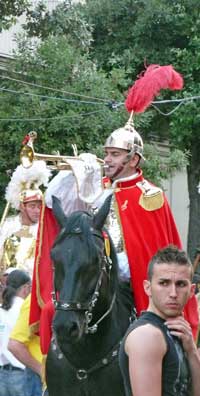
More about Matera and the Festa della Bruna
Matera is a very attractive southern town, with some grand buildings including churches and palaces. What makes the town really special though, is the area of cave-houses on the slopes below the old citadel, perched on the brink of a ravine. The cave-districts, called the Sassi, are a UNESCO World Heritage site.
> Read more about Matera.
The two quiet, haunted cave-districts of Matera are nowadays frequented mostly by tourists who stay at atmospheric cave-hotels and explore the fascinating history of the Sassi. The town centre a short distance above is not at all touristy, despite its charm, and the contrast between the two parts of town is particularly remarkable during the Festa della Bruna. Rambling around the lanes and staircases between cave-houses and rupestrian churches, tourists have little indication of the lively celebrations going on just ten minutes walk away. During the evenings leading up to the Festa della Bruna, the upper part of Matera is ornamented with huge, extravagant coloured light decorations. Residents pause for a chat during the thronged passeggiata, or buy candyfloss and balloons for their children. Since summer daytimes can be so hot, the evenings are a preferred time for socialising and you’ll see whole families out promenading until midnight or later.
Festival calendar
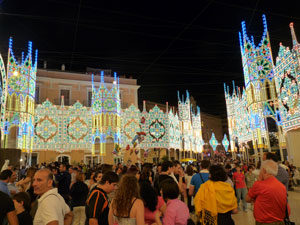
I’ve included a link on the right to a festival website where you should be able to check the current year’s schedule; your hotel should also be a good source of information.
In the days leading up to the 2nd July, according to our guide, ‘no-one in Matera sleeps.’ As well as religious ceremonies, there are also firework displays, music from traditional local town bands and the presentation of this year’s ‘chariot’. On the morning of the big day, 2nd July, inhabitants of Matera (and startled tourists) are awoken by explosive fireworks early in the morning – a wake-up call, for the first of the day’s events are underway. During the course of the day there is more traditional musical entertainment and more processions. At noon the statue of the Madonna della Bruna is escorted to a church in the suburb of Piccianello by a procession of cavalieri – ‘knights’ on horseback, sworn to the service of the Madonna, each with their own fancy costume and individually embroidered cloak. The streets are lined with bystanders, many of whom have arranged (and padlocked) their own chairs onto the pavements in vantage points. After another musical concert, there is a break during which locals can repair to their homes for a meal or a siesta, in preparation for the most important part of the festival.
The big procession
On the evening of the 2nd July, following on from her earlier perambulations, the statue of the Madonna makes her ritual journey back into central Matera, to the Duomo (or, during current restoration works, to the Chiesa di San Francesco). She sets off at around 8pm, esconsced atop a lovingly hand-made float (carro trionfale or triumphal chariot) made of papier-mâché – a real work of art, decorated with ornaments and statues. The grand chariot is pulled by mules and escorted by the columns of knights on horseback, by a marching band, and by Church and State dignitaries. This procession stops every few yards, and for an outsider seems to move painfully slowly. But for locals the slow progress is a chance to enjoy the once-a-year atmosphere, to hail friends among the procession, to approach the bold and frisky horses, and to admire the extravagant chariot.
Perhaps everything that has happened so far seems like a fairly typical Italian religious festival. But a first hint of something not quite normal comes after the float has jolted by. A police cordon holds back a mob who follow the procession eagerly and resemble nothing so much as a crowd of excited football supporters. With a bizarre mixture of motivations – from religious devotion to competitive aggression – these crowds will later fall upon the chariot like vultures and rip it apart. Before that happens, however, the procession must wend its way through the heart of town, dividing the crowds and passing the twinkling festival decorations. In the main square, Piazza Vittorio Veneto, there is a pause for a prayer, entrusting the city to Mary’s holy protection.
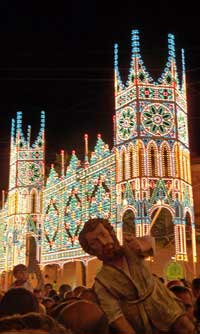
When it finally reaches its destination, the chariot makes a ritual three circuits. Then the bewigged statue of the Madonna (somewhat resembling England’s Charles II) is lifted free with reverence, and escorted into the church. At this point, our guide explained, the chariot is ‘no longer holy’. A piece of the papier-mâché decoration is removed and given to the man who has driven the vehicle this far; his ‘payment’ for the task. Anticipation mounts through the town, with eager crowds jostling along the float’s return route, and a more staid audience shifting patiently in front of big screens beyond. The bizarre, expectant atmosphere, buzzing with a kind of eager thirst for destruction, was one of the most remarkable moments of the festival for me.
In theory, the chariot is supposed to be escorted back to the open space at the beginning of Piazza Vittorio Veneto, where it is handed over to the crowd for its ritual destruction. Taking home a piece of the float is thought to bring luck; perhaps a special favour from the Madonna herself, and the competition is fierce.
It has been known that the pushing, swelling mob have broken through the police protection and clambered onboard, ripping off the decorations, before the traditional handover point. When that happens, our guide told us with a touch of pride, there may be a three-way battle as outraged locals take on the over-eager destroyers, and the police struggle to contain both elements of the crowd. Nothing quite so dramatic happened when we visited. In the safety of the larger open space of Piazza Vittorio Veneto, in front of big screens, the strange blood-lust infected old and young as the chariot jolted precariously from the safety of the church and back towards its doom. But when the first macho ‘vandal’ leaped onto the float and started grappling with an angel, the anti-climax set in quickly. ‘It’s too soon’ muttered an exasperated local, jerking his arm at the screen as though criticising a poor shot from his football team. After a couple of moments spent watching footage of the rapid wreckage, or craning their necks for a real-life glimpse of the events a few hundred yards away, the crowd began chatting again, and dispersing. Having begun to fear some kind of frenzied pagan celebration of the violence, this seemed almost disappointingly tame.
Within minutes, hulking young men began passing through the crowd carrying their trophies above their heads: statues of saints; pastel-painted ornaments; a papier-mâché seagull; some flowerpots. Everyone let them pass with respect; whether this was for their demonstrated physical prowess or because their prizes had religious sanctity, I couldn’t guess. The less tough came away with smaller relics: a strip or fragment of cardboard pulled from the rapidly-diminishing skeleton. At this point, many of the crowd went home, while others headed towards the caves in the Sassi districts for the final part of the long day’s entertainment.
Fireworks
A big firework display, accompanied in recent years by a musical soundtrack, is the hugely dramatic conclusion to the events of the 2nd July. It takes place over the ravine, with fireworks being set off, and music speakers installed, on the uninhabited far side of the gorge, the Murgia Timone. The slopes of the cave district are the best place for watching the fireworks, and for a few hours local residents, Materani, flood back into this ancestral part of their town, temporarily outnumbering the tourists.
The firework display starts at around midnight, allowing time for the procession’s excitement to die down, and the crowds to trickle down the lanes to viewing spots. With huge fireworks igniting at intervals along the plateau, gigantic coloured explosions in the sky, bangs echoing off the rock faces and loud imposing recorded music (the Grand March from Aida; Land of Hope and Glory) this was an absolutely epic spectacle, and a fitting climax to a very memorable evening. Even here, there were reminders of the evening’s appetite for destruction: the fireworks sparked some huge blazes among the rocks opposite – ‘quite normal’ apparently – necessitating some rock-scrambling from firemen with hoses.
Incredibly, this is still not the end of the festivities – more events take place over subsequent days – but this is definitely a grand climax, and a great entertainment for everyone, local or visitor.
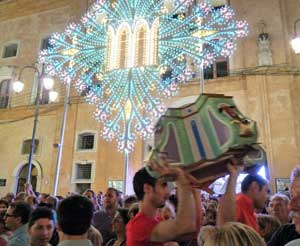
Practicalities
If you’re visiting Matera during the festival (which, despite the summer heat, I’d highly recommend), I’d suggest asking locally about events. There’s nothing like hearing the story of a festival from locals – our tourist guide really built up the drama for us, and any guide or hotel staff member should be able to provide practical advice about timing, where to watch from and so on. Ask them to show you the processional route on a map; planning ahead will help avoid the inconvenience of finding your way blocked by crowds.
Take some water and eat early, or buy food while you wait for the procession. Most shops in Matera are closed on the 2nd July, but takeaway bars and pizza shops do a roaring trade. Be aware that although the general atmosphere is very civilised – alcohol doesn’t play a part – and you’ll see everyone from babies to ancients, the central area does get very crowded. If this is likely to bother you, look for a vantage point close to an entrance to the Sassi (assuming this is where you’re staying) so that you can nip down into the quiet lanes when you want to escape. As is clear from the description above, the area immediately surrounding the ‘destruction’ is best avoided unless you are big, strong and in an adventurous frame of mind. As a foreigner, you’ll be a rarity among the crowd, who in our experience were intrigued and gratified we were witnessing their special festival.
Accommodation
When I visited Matera for the Festa della Bruna, I stayed at the Hotel Sant’Angelo, a four-star hotel in the Sassi, with cave bedrooms. The terraces around the hotel’s scattered rooms had excellent views of the firework display; one or two rooms have balconies from which you could enjoy the show. The three-star Locanda di San Martino is another good place to stay in the Sassi, and is just downhill from the main events in the upper town.
> Matera hotel availability search
I attended the Festa della Bruna as a guest of Basilicata APT, the regional tourist board. Their official UK website can be visited at Discover Basilicata UK.
On this site
Locanda di San Martino, Matera
Puglia and Matera: a travel itinerary
Useful external links
Festa della Bruna website with videos, images and programme
ViaMichelin (driving routes)
Discover Basilicata UK official tourism website
